Spotlight on Industrial Designers

Twelve fabulous-looking consumer products and their forward thinking designers are currently gracing the upper right hand corner of America’s snail mail. In a nod to great product design, The U.S. Postal Service is recognizing the cream of the crop of industrial designers from the 20th century with a specially issued sheet of forever stamps. The featured stamps range from Raymond Lowey’s 1933 Teardrop Pencil Sharpener to Henry Dreyfuss’s 1937 standard issue Model 302 Bell Telephone. I’ve scooped up a stack of these “Pioneers of American Industrial Design” stamps because I love everything about them including the nostalgia generated by the products and the oh-so-creative designers and their objects. I especially like the layout of the sheets and the crisp photos of the products standing in sharp contrast to the simple white background.
Not since the 1939 New York World’s Fair with its “Design For Tomorrow” theme and the Museum of Modern Art’s 1950 “Good Design” exhibit, have so many objects of “excellent appearance” and “progressive performance” received the attention and spotlight they deserve. These twelve industrial designers, whose profession and products grew out the availability of modern materials and new manufacturing processes, were active in the years following the First World War. Their designs stem from aerodynamic steamships and airplanes as well as from the craftsmanship of the Bauhaus.
Today, these twelve designers are widely recognized as artists. Norman Bel Geddes, whose 1938 Patriot Radio is one of the featured stamps, predicted this as early as 1932. Bel Geddes wrote in Horizons in Industrial Design, “Just as surely as the artists of the fourteenth century are remembered by their cathedrals, so will those of the twentieth be remembered for their factories and the products of those factories.”
Whether or not you are lucky enough to own one of these useful products, you can easily remember them each time you attach a stamp to an outgoing envelope.
The Industrial Pioneers and Their Featured Products:
Peter Muller-Munk’s (1904-1967) stamp features his famous Normandie Pitcher. Made in 1935 by Revere Copper and Brass, the streamlined, unadorned curved pitcher, is a classic example of Art Deco design. Named after the French ocean liner Normandie, which also debuted in1935, the Normandie Pitcher was made out of the industrial material chromium-plated brass. Mueller-Munk emigrated to American from Germany in 1926 after studying as a silversmith at the University of Berlin. His career path led him from a metalworker position at Tiffany’s, to the Carnegie Institute of Technology, to the establishment of his own firm in 1938.
Frederick Hurten Rhead’s (1880-1942) stamp displays two pitchers from his popular Art Deco styled Fiesta line of ceramic dinnerware. Fiesta ware was designed in 1936 for the Homer Laughlin China Company in Newall, West Virginia, where Rhead was art director. The mass produced Fiesta ware with its mix and match colors and pieces continues to be extraordinarily popular. Rhead, who began working and designing pottery in his native England, created several other tableware designs for Laughlin. But it is the Fiesta line that Rhead will be most remembered. My grandmother had an entire set of Fiesta ware. If only we had saved them.
Raymond Lowey’s (1893-1986) stamp portrays his Teardrop Pencil Sharpener. Designed in 1933 as a prototype, the chromium-plated tool evokes the look of speed with aerodynamic curves borrowed from the designs of ships, planes and trains popular at the time. Often referred to as the Father of Industrial Design, Lowey is perhaps the most famous and successful industrial designer in this distinguished group. Born in Paris, France, Lowey became a U.S. citizen in 1938 and went on to make a significant impact on the American way of life with the many products he designed. Included in the long list of his designs are: the Lucky Strike cigarette package, 1942; the Studebaker Starliner Coupe, 1953; the Greyhound Bus and logo, 1954; the Slenderized Coca-cola bottle, 1955; the Exxon logo, 1966; and the Shell International logo, 1971. Loewy appeared on the cover of Time magazine in 1949 and won numerous awards for his streamline designs that to this day, still have an impact on American culture.
Donald Deskey’s (1894-1989) Table Lamp, designed between 1927-1931 is the subject of the fourth stamp in the series. This lamp still looks quite contemporary today. A shiny metal concave curved spine attaches its painted black wooden base to the metal hemispherical lampshade. Deskey cleverly designed the swivel lampshade by attaching a ball-and-socket joint. The overall design, like many others of the day, is streamlined. Among Deskey’s other recognizable designs are the Art Deco interiors of Radio City Music Hall in New York City. In addition, his legacy includes package designs for products ranging from Crest Toothpaste to Aqua Velva After Shave lotion to Cheer and Oxydol laundry detergents. Deskey was a native of Blue Earth, Minnesota.
Walter Dorwin Teague’s (1883-1960), Baby Brownie Camera, graces the postage stamp produced in his honor. The box shaped camera, made of black Bakelite featuring strong Art Deco detailing, is just one of several cameras Teague designed for Kodak. Born in Decatur, Indiana, Deskey viewed industrial design as both an art and a keystone of modern life. He served on the board of the 1939 World’s Fair and is credited with phrasing the fair’s theme: “Building the World of Tomorrow.” In 1944 Teague and Dorwin established the American Society of Industrial Engineers. Teague served as its first president.
Henry Dreyfuss’s (1904-1972) iconic Model 302 Tabletop Telephone is one of the most recognizable industrial designed objects in America. Even in this age of cellular phones Dreyfuss’s model is instantly identifiable as the classic American telephone. Manufactured in 1937 by Western Electric, the Model 302 was the first phone to include the ringer and anti-side tone circuitry in the same unit. Dreyfuss’s phone was originally made from cast zinc shells and had a straight (not coiled) cord covered with brown woven fabric. Born in Brooklyn, New York, Dreyfuss apprenticed under another famous industrial design pioneer — Norman Bel Geddes. His other well-known products include the Big Ben Alarm Clock in 1939 for Westclox, the circular wall thermostat in 1953 for Honeywell, and the favorite product of 1959 for suburban teenage girls –the Princess Telephone for Bell Systems.
Norman Bel Geddes’s (1893-1958) Patriot Radio is the red, white and blue object of his dedicated stamp. Marketed by Emerson Radio in 1940, the catalin incased Patriot is another striking example of Art Deco and streamlined design. Bel Geddes once said, “Speed is the cry of our era and greater speed one of the goals of tomorrow.” He didn’t just say that, but he believed it and brought those words to life in his design for General Motors’s “Futurama” pavilion at the 1939 New York World’s Fair. Born in Cleveland, Ohio, Bel Geddes studied art at the Cleveland Institute of Art and the Art Institute of Chicago.
Dave Chapman’s (1909-1978), stamp puts the spotlight on his streamlined Sewing Machines. Designed in 1949 for the White Sewing Machine Company of Cleveland, Chapman’s sewing machine features a sleek chrome grill similar in design to automobile grills. A native of Gilman, Illinois, Chapman studied architecture at the Armour Institute of Technology and worked as head of product design for Montgomery Ward from 1933-36. He later opened his own firm and produced numerous products for his clients Corning Glass, Maytag, Hamilton Beach and Sears.
Greta Von Nessen (1900-1974) is the only female industrial designer to be included in this group of industry pioneers. Even though most of the products were used by women or made specifically for their gender, women weren’t typically accepted into the field of industrial design. This didn’t hinder Von Nessen, a native of Sweden, from graduating from Sweden’s School for Industrial Arts. Along with her husband the industrial designer Walter von Nessen, she established the successful New York firm Nessen Studio. They specialized in the design of lamps and lighting fixtures. It is here in 1951 that she designed the Anywhere Lamp pictured on her stamp. It features an aluminum base and an adjustable shade that was available in a variety of colors. Von Nessen’s unique design allowed this lamp to literally go Anywhere from the top of a table to being mounted on a wall, to being suspended from the ceiling.
Eliot Noyes’s (1910-1977) Selectric Typewriter is the one product appearing on this sheet of stamps that I actually remember using. I’m old enough to remember this popular device. The IBM Selectric I Typewriter first appeared on the market in 1961. Even though electric typewriters had been around since 1920 (invented by James Smathers), Noyes’s design was considered revolutionary because it featured a moving interchangeable spherical “golf ball” printing element. The carriage itself remained fixed. By 1975, nearly 75 percent of typewriters used in the U.S. were Selectric Typewriters. Just a few short years later, of course, typewriters all but disappeared following the growth of personal computers. The Boston born Noyes was a Harvard trained architect who worked for legendary designers Marcel Breuer and Walter Gropius. He worked as a curator for the Museum of Modern Art, and in 1941 he became director of the museum’s new department of Industrial Design.
Russel Wright’s (1904-1976), Highlight Pinch Flatware is featured on the stamp bearing his name. Born in Lebanon, Ohio, Wright studied art and architecture in New York before apprenticing for Norman Bel Geddes. Wright and his wife Mary established a very successful design business that specialized in modern furniture and accessories for the home. In 1934 he designed the first sectional sofa, and a year later his American Modern line of bleached blond maple furniture pushed him into widespread notoriety. In 1950 Wright designed the minimal yet elegant Highlight Pinch Flatware. True to Modernist thinking, Wright’s stainless steel flatware featured organically shaped handles and no applied ornament.
Gilbert Rohde’s (1894-1944) Art Deco Electric Table Clock was designed in 1930 for the Herman Miller Company. The face of the clock features black glass and rests atop a chrome base. Rohde replaced the traditional clock numbering system with chrome balls to mark the hours. Born in New York City, Rhode was a high school drop out who began his career as a political cartoonist for the Bronx News. His inspiration for modernism and modern design came after a trip to the 1925 Paris Exposition des Arts Decoratifs et Industriels. As Design Director for Herman Miller, Rhode was among the first at the company to design modern furniture based on functionality, minimalism and biomorphic shapes.
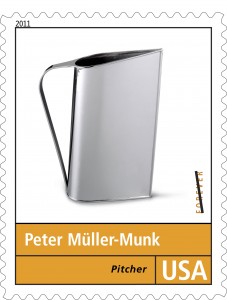
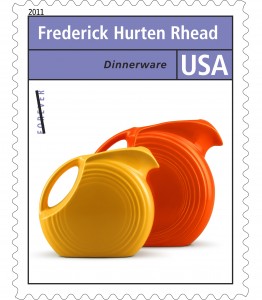
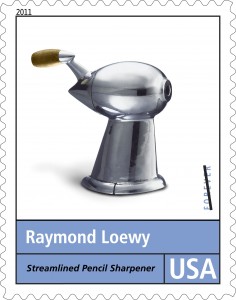
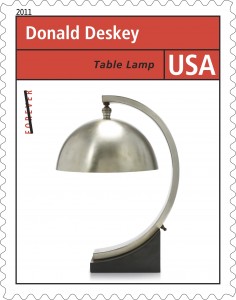
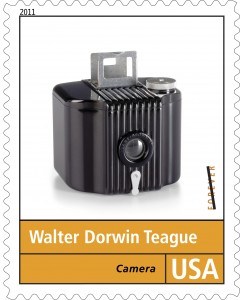
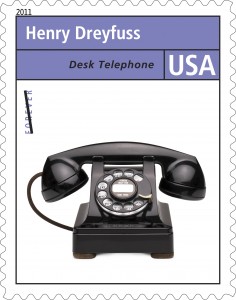
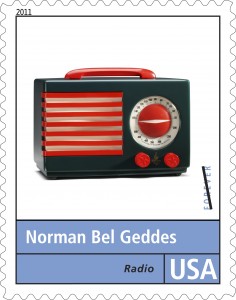
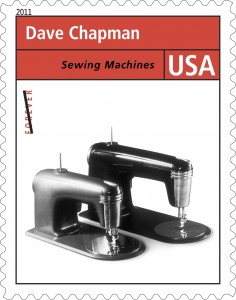
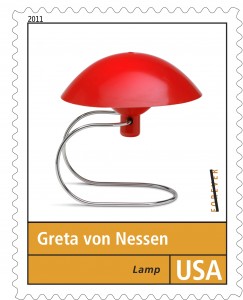
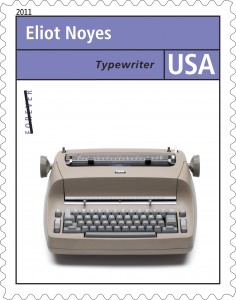
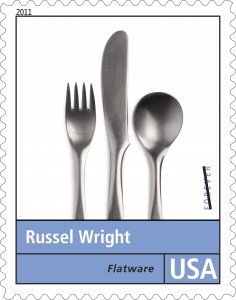
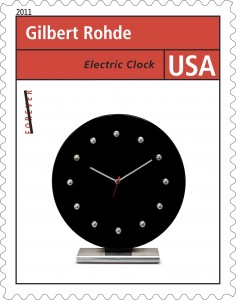



I was so excited to see these stamps! I’ve been collecting Russel Wright for 30 years. His designs are amazing. There’s an exhibit on Raymond Loewy in Roanoke, VA, that I saw two weeks ago. I’m glad there is an interest in the industrial design of the last century–the forms are beautiful. I wonder what pieces/which designers will be remembered from today?
This excellent website definitely has all the
info I needed about this subject and didn’t know who to ask.
Enjoyed looking through this, very good stuff, thanks .
I just want to say I am just newbie to weblog and really savored you’re blog site. Almost certainly I’m going to bookmark your blog post . You definitely have good articles and reviews. Thanks a lot for revealing your web-site.
Great article.
I really like your writing style, excellent info, thanks for posting :D. “If a cluttered desk is the sign of a cluttered mind, what is the significance of a clean desk” by Laurence J. Peter.